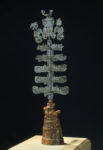
Unknown
Chinese, eastern Han dynasty
Money Tree, 25-220 CE
bronze with glazed earthenware base
60 x 12 in.
SBMA, Gift of the Rubin-Ladd Foundation
2016.12

Money Tree described in comments.
COMMENTS
Story of the Money Tree
One folktale from China tells of a farmer who has a tree with two legs and two arms. This tree works every day to bring him endless money, food, and clothing. The farmer’s greedy brother and stepmother become jealous and steal the tree. When the tree fails to produce money, the farmer reveals that the two legs and arms were actually his own, and that his hard work was what earned him wealth. The farmer’s brother woke up to reality, and from then on worked hard, creating another money tree.
Detailed description of a Money Tree:
Money trees offer a fascinating glimpse into regional and metropolitan Chinese Han dynasty (206 BCE‒220 CE) beliefs. Most of these rare sculptures were probably made in Sichuan province and other parts of western China. The replicas of coins that hang from their limbs symbolize wishes for good fortune in the afterlife. A money tree was placed in a tomb so the occupant’s soul might have wealth while residing in the paradise of the Queen Mother of the West, Xiwang Mu.
A Queen Mother figure was placed near the top of the money tree. She sits on a throne supported by a dragon and a tiger. Further down the tree is a seated Buddha. Early Buddha images are found in some objects associated with Xiwang Mu perhaps because Buddhism was considered a religion of the Western direction, where the Queen Mother resided. A number of winged immortals (Xianxian), the residents of the Queen Mother’s paradise, can also be seen on this tree.
The casting of the many individual pieces that make up this ensemble is remarkable. Each piece is very thin and bears the same decoration on both sides; X-ray analysis shows that the patterns line up exactly. This was made possible by precise control of the lost-wax casting process. Take a close look at the glazed pottery base, where you will see lively scenes of a type rarely found in Chinese art.
http://education.asianart.org/explore-resources/artwork/money-tree-probably-100-200
This object represents a type of funerary good called a “money tree” (qian shu) or “money-shaking tree” (yao qian shu). In the extant texts, the term “money tree” first appeared in the eighth century A.D. It is, however, unclear if there was any connection between early discoveries and later records. Based on about two hundred examples known to us, the use of money trees in Han China was prevalent in the southwest and was popular from the first to third century A.D.
https://www.metmuseum.org/art/collection/search/640957
SBMA CURATORIAL LABELS
This is called “money tree” because of the coins (round, fringed shapes with square holes) that hang from what appear to be the branches of a stylized tree. Objects like this are found in Han and post-Han tombs around Sichuan province in western-central China as part of the funerary furniture produced for the well-being of the deceased in the afterlife, a belief still practiced among many Chinese communities in Asia.
Money trees have auspicious meaning centering on the concept of immortality and Xiwangmu, Queen Mother of the West—an early deity in Chinese mythology thought to dispense long life. The towering tree suggests her mountain residence with fantastic beasts and creatures like phoenixes, dragons, and tigers who roam freely among hunters and other animals. The airiness of the individual branches and the continuous curvilinear forms suggest motion and lightness of an ethereal realm of the immortals where the deceased souls aim to reach.
The tree branches are cast incredibly thin with identical designs on both sides, revealing precise control of the lost-wax casting process. The molded ceramic base, though damaged, also carries auspicious meaning with two fantastic lion-like animals, one on top of another, surrounded with roaming immortals and animals.
- SBMA Wall Text, 2018
